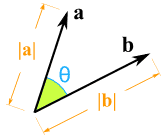Vectores Definiciones, operaciones, simuladores online
https://www.mathsisfun.com/algebra/vectors.html
https://phet.colorado.edu/sims/html/vector-addition/latest/vector-addition_all.html
Vectors
This is a vector:
A vector has magnitude (size) and direction:
The length of the line shows its magnitude and the arrowhead points in the direction.
Play with one here:
We can add two vectors by joining them head-to-tail:
And it doesn't matter which order we add them, we get the same result:
Velocity, acceleration, force and many other things are vectors.
Subtracting
We can also subtract one vector from another:
- first we reverse the direction of the vector we want to subtract,
- then add them as usual:
a − b
Notation
A vector is often written in bold, like a or b.
| A vector can also be written as the letters of its head and tail with an arrow above it, like this: |  |
Calculations
Now ... how do we do the calculations?
The most common way is to first break up vectors into x and y parts, like this:

The vector a is broken up into
the two vectors ax and ay
(We see later how to do this.)
Adding Vectors
We can then add vectors by adding the x parts and adding the y parts:
The vector (8, 13) and the vector (26, 7) add up to the vector (34, 20)
When we break up a vector like that, each part is called a component:
Subtracting Vectors
To subtract, first reverse the vector we want to subtract, then add.
Magnitude of a Vector
The magnitude of a vector is shown by two vertical bars on either side of the vector:
|a|
OR it can be written with double vertical bars (so as not to confuse it with absolute value):
||a||
We use Pythagoras' theorem to calculate it:
|a| = √( x2 + y2 )
A vector with magnitude 1 is called a Unit Vector.
Vector vs Scalar
A scalar has magnitude (size) only.
Scalar: just a number (like 7 or −0,32) ... definitely not a vector.
A vector has magnitude and direction, and is often written in bold, so we know it is not a scalar:
- so c is a vector, it has magnitude and direction
- but c is just a value, like 3 or 12,4
Multiplying a Vector by a Scalar
When we multiply a vector by a scalar it is called "scaling" a vector, because we change how big or small the vector is.
(And now you know why numbers are called "scalars", because they "scale" the vector up or down.)
Multiplying a Vector by a Vector (Dot Product and Cross Product)

How do we multiply two vectors together? There is more than one way!
- The scalar or Dot Product (the result is a scalar).
- The vector or Cross Product (the result is a vector).
(Read those pages for more details.)
More Than 2 Dimensions
Vectors also work perfectly well in 3 or more dimensions:
The vector (1, 4, 5)
Here is an example with 4 dimensions (but it is hard to draw!):
Magnitude and Direction
We may know a vector's magnitude and direction, but want its x and y lengths (or vice versa):
 | <=> |  |
| Vector a in Polar Coordinates | Vector a in Cartesian Coordinates |
You can read how to convert them at Polar and Cartesian Coordinates, but here is a quick summary:
| From Polar Coordinates (r,θ) to Cartesian Coordinates (x, y) | From Cartesian Coordinates (x, y) to Polar Coordinates (r,θ) | |
|
|
An Example
Sam and Alex are pulling a box.
- Sam pulls with 200 Newtons of force at 60°
- Alex pulls with 120 Newtons of force at 45° as shown
What is the combined force, and its direction?
Let us add the two vectors head to tail:
First convert from polar to Cartesian (to 2 decimals):
Sam's Vector:
- x = r × cos( θ ) = 200 × cos(60°) = 200 × 0,5 = 100
- y = r × sin( θ ) = 200 × sin(60°) = 200 × 0,8660 = 173,21
Alex's Vector:
- x = r × cos( θ ) = 120 × cos(−45°) = 120 × 0,7071 = 84,85
- y = r × sin( θ ) = 120 × sin(−45°) = 120 × -0,7071 = −84,85
Now we have:
Add them:
(100.173,21) + (84,85, −84,85) = (184,85, 88,36)
That answer is valid, but let's convert back to polar as the question was in polar:
- r = √ ( x2 + y2 ) = √ ( 184,852 + 88,362 ) = 204,88
- θ = tan-1 ( y / x ) = tan-1 ( 88,36 / 184,85 ) = 25,5°
And we have this (rounded) result:
And it looks like this for Sam and Alex:
They might get a better result if they were shoulder-to-shoulder!















No hay comentarios:
Publicar un comentario